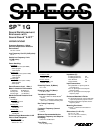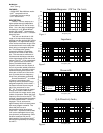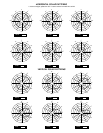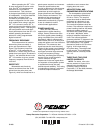
When operating the SP
™
1G in
bi-amp mode with an active cross-
over, the CS
®
X1 input/crossover
module for the CS
®
800S is
recommended. This crossover
is designed specifically for this type
of loudspeaker. It may be obtained
as an add-on feature to the
CS 800S at a modest cost. The
proper configuration for this cross-
over module when using it with the
SP
™
1G is to have it set to SP
™
2
mode and reverse the polarity of the
high-frequency driver. This will give
the best possible sonic and direc-
tional performance from the SP
™
1G
without spending hundreds of
dollars for a fully programmable
digital crossover.
FREQUENCY RESPONSE
This measurement is useful in
determining how accurately a
given unit reproduces an input
signal. The frequency response
of the SP
™
1G is measured at a
distance of 1 meter using a 2.8 volt
swept-sine input signal. As shown in
Figure 1, the selected drivers in the
SP
™
1G combine to give a smooth
frequency response from 50 Hz to
19.0 kHz.
DIRECTIVITY
Beamwidth and directivity
factors are derived from the -6 dB
points from the polar plots (see
Figure 3), which are measured in a
whole space anechoic environment.
These are specifications that
provide a reference to the coverage
characteristics of the unit. These
parameters provide insight for
proper placement and installation
in the chosen environment. The
blending of the components of
the SP 1G exhibit a desirable
beamwidth and directivity (Figures
3 and 4) suitable for sound
reinforcement applications.
POWER HANDLING
There are many different
approaches to power handling
ratings. Peavey Electronics rates
this unit’s system power handling
using a modified form of the AES
Standard 2-1984. It utilizes audio
band limited (20 Hz to 20 kHz) pink
noise with peaks over four times the
RMS level. This strenuous test
signal assures the user that every
portion of this system can withstand
today’s high technology music. The
test signal contains large amounts
of very low-frequency energy,
effectively simulating the frequency
content of live music situations.
The full measure of high
frequencies in the test signal allow
for exposure of the speaker system
to synthesized tones that may
extend beyond audibility. This rating
is contingent on having a minimum
of 3 dB of amplifier headroom
available so as to ensure that
clipping does not occur.
ARCHITECTURAL AND
ENGINEERING SPECIFICATIONS
The loudspeaker system shall
have an operating bandwidth of
50 Hz to 19 kHz. The nominal
output level shall be 99 dB when
measured at a distance of one
meter with an input of one watt.
The nominal impedance shall be
8 ohms. The maximum continuous
power handling shall be 450 watts,
maximum program power of
900 watts and a peak power input
of at least 1,800 watts, with a
minimum amplifier headroom of
3 dB. The nominal radiation
geometry shall be 77 degrees in the
horizontal plane and 63 degrees in
the vertical plane. The outside
dimensions shall be 33.75 inches
high by 19.0 inches wide by
20 inches deep. The weight shall
be 95 pounds. The loudspeaker
system shall be a Peavey model
SP
™
1G.
THREE PLUS TWO YEAR
LIMITED WARRANTY
NOTE: For details, refer to the
warranty statement. Copies of this
statement may be obtained by
contacting Peavey Electronics
Corporation, P.O. Box 2898, Meridian,
Mississippi 39302-2898.
Features and specifications subject to change without notice.
Peavey Electronics Corporation • 711 A Street • Meridian, MS 39301 • U.S.A.
(601) 483-5365 • Fax 486-1278 • www.peavey.com
©1998 Printed in U.S.A. 9/98
80304481






